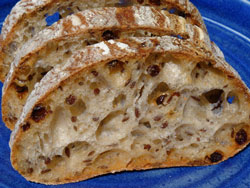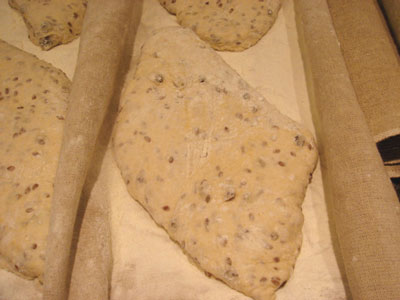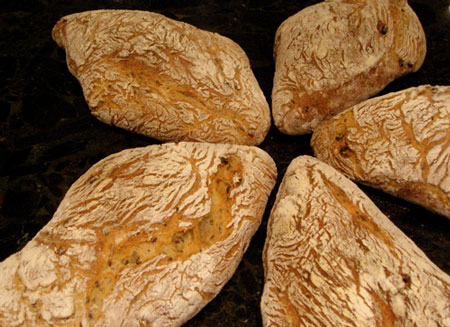 If I’m being honest, I must say that neither flax seeds nor currants make my list of favorite taste sensations. So no one is more surprised than me that this rustic bread freckled with these prosaic little ingredients is nothing short of magnificent.
If I’m being honest, I must say that neither flax seeds nor currants make my list of favorite taste sensations. So no one is more surprised than me that this rustic bread freckled with these prosaic little ingredients is nothing short of magnificent.
Nutty and light with an occasional hit of sweetness provided by the fruit, flax seed-currant bread is equally at home for breakfast with a drizzle of honey, sliced horizontally for hearty ham sandwich , or after dinner with fruit and cheese.
This bread, adapted from a recipe I learned at SFBI, has a texture similar to ciabatta, and it uses the same double-hydration mixing technique: reserve a portion of the water to be added after the gluten is developed, to achieve a strong, but very soft and wet, dough. The seed soaker and currants are added at the end of mixing to avoid having them interfere with the gluten development.
Rustic Flax Seed-Currant Bread
Yield: 2.3 g (6 – 8 small loaves). The recipe can easily be halved.
Time:
- Mix and ferment poolish: 12 hours (flax seeds also soak during this time)
- Mix final dough: 10 – 15 minutes
- First fermentation: 2.5 hours, with folding after 1.5 hours
- Divide: 5 minutes
- Proof: 45 – 60 minutes at room temperature, or 1.5 hours in the refrigerator plus 45 minutes at room temp
- Bake: 40 minutes
Desired dough temperature: 76F
Poolish Ingredients:
- 215 g white flour (I used Giusto’s Golden Haven organic)
- 215 g water at about 70F
- 0.2 g instant yeast (1/16 t.)
Soaker Ingredients:
- 103 g dark flax seeds (can be toasted for better flavor)
- 154 g water
Final Dough Ingredients:
- 729 g white flour
- 86 g fine whole wheat flour
- 43 g fine whole rye flour
- 601 g cool water (about 50F)
- All of the poolish
- 21 g salt
- 4 g instant yeast (1 1/3 t.)
- 129 g dried currants
- All of the soaker
Method:
- In a large bowl, mix the poolish ingredients until just combined. Cover the bowl and let the poolish ferment at room temperature for about 12 hours. It is ready to use when the surface is creased, and pebbled with bubbles.
- Meanwhile, combine the flax seeds and soaker water in a small bowl and let stand at least 2 hours.
- Place the final dough flours, yeast, salt, poolish, and all but about 20% of the water, into the bowl of a stand mixer. Mix on low speed until the ingredients are incorporated, about 4 or 5 minutes. The dough should have a medium consistency at this point (similar to a basic French or sourdough bread).
- Continue mixing on low or medium speed until the dough reaches a medium level of gluten development. This might take about 5 minutes, but will depend on your mixer.
- Add the remaining water (and even more, if needed) and continue mixing until it is all incorporated and you have a dough that feels very soft and stretchy, yet strong and springy.
- Add the soaker and currants and mix in low speed until they are evenly distributed through the dough.
- Transfer the dough to a well-oiled container.
- Ferment at room temperature for about 2.5 hours, folding the dough after 1.5 hours. For this wet dough, I prefer to turn it out onto a liberally floured counter for folding, rather than folding right in the container. Make sure the container is well oiled before returning the dough to it.

- Turn the dough out onto a very well floured counter.
- Working from the center towards the edges, very gently stretch the dough into a rectangle about 2 cm in height. Try to degas the dough as little as possible.
- With a dough scraper, cut the dough into diamond-shaped or rectangular pieces. Gently lift these pieces to a floured couche, supporting the entire piece from underneath and keeping the floured side of the dough down. Again, be careful to degas as little as possible.
- Cover the couche with plastic or slip it, on a board or sheet pan, into a large food-grade plastic bag.
- Proof for 45 – 60 minutes at room temperature, until the dough is very light and full of gas. Or place the loaves in the refrigerator for 1.5 hours, then at room temperature for another 45 minutes.
- Meanwhile, preheat the oven, with baking stone, to 440F. You will also need steam during the initial phase of baking, so prepare for this now.
- Prepare a piece of parchment paper the size of your baking stone, and put it on a board or sheet pan.
- Sprinkle the loaves lightly with flour and flip them gently onto the parchment-covered pan, so the heavily floured side is now up. Do not score the loaves.
- To bake, slide the loaves, parchment and all, onto the baking stone.
- Bake for 8 minutes with steam, and another 27 minutes or so without steam. Crack the oven door open during the last 5 minutes of this time. The crust should be a golden brown. Then turn off the oven and leave the loaves in for another 5 minutes, still with the door ajar.
- Cool on a wire rack. Wait until completely cool to cut and eat.



Those look very yummy indeed. I can imagine that they were excellent. Would runny honey be a faux-pas because of the large holes in the crumb?
Regards,
Nils
I just dropped by to check out your sight. You are absolutely amazing! The techniques in your bread making are truly expert!
Isn’t bread wonderful?!?! The way it brings together strangers and families and unites cultures. I simply love everything there is about bread and the role it plays in our lives.
I will definitely be dropping in from time to time to see what you have baking up 🙂
Lewis
Table Bread
http://www.tablebread.blogspot.com
Nils: Yes, runny honey could be a bit messy, but if you cut the slices thicker, or horizontally, you should be able to get slices without holes that go all the way through. I really love the way this tastes with just a bit of honey.
Lewis: Thank you for the kind words and welcome to my blog!
I love currants and flax seed! (Hmmm, do you think that might mean I’ll dislike the bread made with them? ;-))
I am particularly impressed with the holey texture. This is what my husband is REALLY wanting from the bread I bake and I have never quite achieved it. Even when I do get the varied sizes of holes, the crumb is still quite moist and somewhat heavy. I bake it til the internal temperature is around 210-215F…
He thinks that I am baking at too high a temperature and creating a barrier for the inside. Any thoughts?
I usually preheat (with a stone) to 500F and then immediately turn the oven down to 400F when putting the bread in. I never spray the oven but always liberally spray the loaves with water.
-Elizabeth
I enjoy flax seeds and it’s fairly common for me to put them in most of my breads. Might have to give this a spin.
Elizabeth, I doubt your baking temp is too hot (although it can happen that a too-hot temperature sets the crust too soon and impedes oven spring). In my experience, the keys to a good open crumb are hydrating the dough (adding enough water), developing the gluten enough but not too much, properly steaming the oven, and not overproofing. I do think most people tend to overproof their loaves.
Tanna, I’ll be looking forward to seeing your take on this bread. I think I had a bad experience with flax seeds once which led me to believe I didn’t like them, but I have to admit that several things I’ve had them in recently were pretty darn good.
Thanks for the advice, Susan. It’s unlikely that it is not enough water (I’m working on a post about hand-kneading slack dough). I’m thinking it could well be overproofing. Or possibly not developing the gluten enough – I think it unlikely that it is over-developed with my hand mixing and hand kneading.
I often see that my loaf splits in the baking. Also, I daren’t slash any of my loaves – they seem at a risk of falling… I really must have the nerve to bake it earlier than I do. I have been tending to wait til it looks a bit like it is shuddering on the peel.
-Elizabeth
This is the best site I have ever stumbled upon!!!
Gena Lora, you are so kind, and I love to be stumbled upon.
And we still miss you. Thank you for leaving the site active – I still use your recipes and advice. This was a delicious bread. I hope life is going so well for you that you don’t have time to post.
om gosh, i just started soaking some linseeds with no idea of what to do with them and i have currents left over from making stollen; i am all over this recipe! thank you!
I recently discovered your blog and have been enjoying it very much. I took a bread class from SFBI last Feb. (whole grains and specialty flours) and remember making this wonderful bread. Well…I was inspired by your posting and made it last night for a potluck. It was better than I remembered!
Do you have an easy way to convert the measurements into cups, etc? I am fairly new to bread baking and can’t seem to figure out grams? Thanks so much your site is wonderful and your breads look fabulous…can’t wait to try some!!
???
thank
Panerai, Radiomir black seal PAM 183 Recollection of historic types of Panerai, the Inky Stamp is really a watch with delightful simplicity, swiss watches duplicate readable and smartly designed. Re-examine gangs. Only for the biographical incident Within the 1940’s, some italian partners had the race to woo youthful British ladies on Midland vacation. Furrowing furtively the lanes of Alexandria or La Valette, driving a 2-square scooter, the Of ancient rome used Rolex watching using the cast of a cushion which continues to be modified by Panerai. The Florentine compressed underlined the markers having a specific luminescent paste known as the Radiomir. Necessary to chronometer their performances within the smoky backrooms, the Panerai watches have joined narration because of these transalpine heroes. A least part of, this is exactly what Luigi explained when he entrusted me together with his Radiomir black Stamp 183, to which i’ve to offer for inspection Gin for any pair of days
I think this is my kind of recipe, so thanks much for the post.
Thank you for the rich detaill and gorgeous photos of how bread can be when well executed. I come and go to breadmaking when the muses move me and you are one of the best.
Currently I am immersed in sourdough starter building as I attempt Nancy Silverton’s starter from her book, “Nancy Silverton’s Breads from the La Brea Bakery: Recipes for the Connoisseur”.
Your website is a joy to new and experienced breaders. Your ciabatta is on my list.
Thank you, I’ve just been looking for information approximately this
subject for ages and yours is the best I’ve came
upon so far. But, what about the bottom line?
Are you positive in regards to the supply?
66c93ce182a4372b9e5e55a6de9855cb